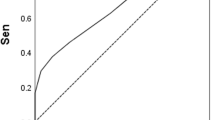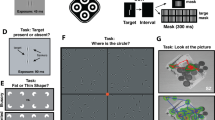Abstract
Depressive disorder is often associated with the subjective experience of altered visual perception. Recent research has produced growing evidence for involvement of the visual system in the pathophysiology of depressive disorder. Using the pattern electroretinogram (PERG), we found reduced retinal contrast response in patients with major depression. Based on this observation, the question arises whether this change has a cortical correlate. To evaluate this, we analyzed the visual evoked potential (VEP) of the occipital cortex in 40 patients with depressive disorder and 28 healthy controls. As visual stimuli, checkerboard stimuli of 0.51° check size, 12.5 reversals per second and a contrast of 3–80 % was used. In addition to the PERG, we recorded the VEP with an Oz versus FPz derivation. The amplitude versus contrast transfer function was compared across the two groups and correlated with the severity of depression, as measured by the Hamilton Depression Rating Scale and the Beck Depression Inventory. Patients with major depression displayed significantly reduced VEP amplitudes at all contrast levels compared to control subjects (p = 0.029). The VEP amplitude correlated with psychometric measures for severity of depression. The degree of depression reduced the contrast transfer function in the VEP to a lesser extent than in the PERG: While the PERG is reduced to ≈50 %, the VEP is reduced to 75 %. Our results suggest that depression affects the cortical response in major depression, but less so than the retinal responses. Modified contrast adaptation in the lateral geniculate nucleus or cortex possibly moderates the increased losses in the retina.


Similar content being viewed by others
References
WHO (2004) WHO | The global burden of disease: 2004 update. In: WHO. http://www.who.int/healthinfo/global_burden_disease/2004_report_update/en/. Accessed 13 Nov 2013
Lopez AD, Murray CCJL (1998) The global burden of disease, 1990–2020. Nat Med 4:1241–1243. doi:10.1038/3218
Nestler EJ, Hyman SE (2010) Animal models of neuropsychiatric disorders. Nat Neurosci 13:1161–1169. doi:10.1038/nn.2647
American Psychiatric Association (2000) Diagnostic statistical manual of mental disorders: DSM-IV-TR, Revised. American Psychiatric Association, Washington, DC
Randrup A, Bræstrup C (1977) Uptake inhibition of biogenic amines by newer antidepressant drugs: relevance to the dopamine hypothesis of depression. Psychopharmacology 53:309–314. doi:10.1007/BF00492370
Chaudhury D, Walsh JJ, Friedman AK et al (2013) Rapid regulation of depression-related behaviours by control of midbrain dopamine neurons. Nature 493:532–536. doi:10.1038/nature11713
Kessler RC, Chiu WT, Demler O, Walters EE (2005) Prevalence, severity, and comorbidity of twelve-month DSM-IV disorders in the National Comorbidity Survey Replication (NCS-R). Arch Gen Psychiatry 62:617–627. doi:10.1001/archpsyc.62.6.617
Tye KM, Mirzabekov JJ, Warden MR et al (2013) Dopamine neurons modulate neural encoding and expression of depression-related behaviour. Nature 493:537–541. doi:10.1038/nature11740
Ebert D, Ebmeier KP (1996) The role of the cingulate gyrus in depression: from functional anatomy to neurochemistry. Biol Psychiatry 39:1044–1050. doi:10.1016/0006-3223(95)00320-7
Ebert D, Berger M (1998) Neurobiological similarities in antidepressant sleep deprivation and psychostimulant use: a psychostimulant theory of antidepressant sleep deprivation. Psychopharmacology 140:1–10
Lammers CH, Diaz J, Schwartz JC, Sokoloff P (2000) Selective increase of dopamine D3 receptor gene expression as a common effect of chronic antidepressant treatments. Mol Psychiatry 5:378–388
Klimek V, Schenck JE, Han H et al (2002) Dopaminergic abnormalities in amygdaloid nuclei in major depression: a postmortem study. Biol Psychiatry 52:740–748. doi:10.1016/S0006-3223(02)01383-5
Nestler EJ, Carlezon WA Jr (2006) The mesolimbic dopamine reward circuit in depression. Biol Psychiatry 59:1151–1159. doi:10.1016/j.biopsych.2005.09.018
Krishnan V, Han M-H, Graham DL et al (2007) Molecular adaptations underlying susceptibility and resistance to social defeat in brain reward regions. Cell 131:391–404. doi:10.1016/j.cell.2007.09.018
Krishnan V, Nestler EJ (2010) Linking molecules to mood: new insight into the biology of depression. Am J Psychiatry 167:1305–1320. doi:10.1176/appi.ajp.2009.10030434
Wilson RS, Nag S, Boyle PA et al (2013) Brainstem aminergic nuclei and late-life depressive symptoms. JAMA Psychiatry. doi:10.1001/jamapsychiatry.2013.2224
Bubl E, Tebartz van Elst L, Gondan M et al (2009) Vision in depressive disorder. World J Biol Psychiatry 10:377–384
Bubl E, Kern E, Ebert D et al (2010) Seeing gray when feeling blue? Depression can be measured in the eye of the diseased. Biol Psychiatry 68:205–208
Bubl E, Ebert D, Kern E et al (2012) Effect of antidepressive therapy on retinal contrast processing in depressive disorder. Br J Psychiatry 201:151–158. doi:10.1192/bjp.bp.111.100560
Teranishi T, Negishi K, Kato S (1983) Dopamine modulates S-potential amplitude and dye-coupling between external horizontal cells in carp retina. Nature 301:243–246
Ghilardi MF, Marx MS, Bodis-Wollner I et al (1989) The effect of intraocular 6-hydroxydopamine on retinal processing of primates. Ann Neurol 25:357–364. doi:10.1002/ana.410250407
Pereda A, Triller A, Korn H, Faber DS (1992) Dopamine enhances both electrotonic coupling and chemical excitatory postsynaptic potentials at mixed synapses. PNAS 89:12088–12092
Ikeda H, Head GM, Ellis CJ (1994) Electrophysiological signs of retinal dopamine deficiency in recently diagnosed Parkinson’s disease and a follow up study. Vision Res 34:2629–2638
Tebartz van Elst L, Greenlee MW, Foley JM, Lucking CH (1997) Contrast detection, discrimination and adaptation in patients with Parkinson’s disease and multiple system atrophy. Brain 120(Pt 12):2219–2228
Langheinrich T, Tebartz van Elst L, Lagreze WA et al (2000) Visual contrast response functions in Parkinson’s disease: evidence from electroretinograms, visually evoked potentials and psychophysics. Clin Neurophysiol 111:66–74
Bach M (2007) The Freiburg visual acuity test-variability unchanged by post hoc re-analysis. Graefes Arch Clin Exp Ophthalmol 245:965–971
Bach M (2000) Freiburg evoked potentials. http://www.michaelbach.de/ep2000.html
American Clinical Neurophysiology Society (2006) Guideline 5: guidelines for standard electrode position nomenclature. J Clin Neurophysiol 23:107–110
Bach M, Meigen T, Strasburger H (1997) Raster-scan cathode-ray tubes for vision research-limits of resolution in space, time and intensity, and some solutions. Spat Vis 10:403–414
Meigen T, Bach M (1999) On the statistical significance of electrophysiological steady-state responses. Doc Ophthalmol 98:207–232
Bach M, Meigen T (1999) Do’s and don’ts in Fourier analysis of steady-state potentials. Doc Ophthalmol 99:69–82
WaveMetrics (2014) WaveMetrics—scientific graphing, data analysis, curve fitting and image processing software. http://www.wavemetrics.com/index.html. Accessed 11 Nov 2014
R Development Core Team (2014) R: A language and environment for statistical computing. http://www.R-project.org. Accessed 18 Aug 2014
Ben-Shlomo G, Bach M, Ofri R (2007) Temporal and spatial frequencies interact in the contrast transfer function of the pattern electroretinogram. Vision Res 47:1992–1999. doi:10.1016/j.visres.2007.04.009
Normann C, Schmitz D, Fürmaier A et al (2007) Long-term plasticity of visually evoked potentials in humans is altered in major depression. Biol Psychiatry 62:373–380. doi:10.1016/j.biopsych.2006.10.006
Joost W, Bach M, Schulte-Mönting J (1992) Influence of mood on visually evoked potentials: a prospective longitudinal study. Int J Psychophysiol 12:147–153
Ohzawa I, Sclar G, Freeman RD (1982) Contrast gain control in the cat visual cortex. Nature 298:266–268. doi:10.1038/298266a0
Heinrich TS, Bach M (2001) Contrast adaptation in human retina and cortex. IOVS 42:2721–2727
Heinrich TS, Bach M (2002) Contrast adaptation in retinal and cortical evoked potentials: no adaptation to low spatial frequencies. Vis Neurosci 19:645–650. doi:10.1017/S0952523802195095
Solomon SG, Lennie P (2005) Chromatic gain controls in visual cortical neurons. J Neurosci 25:4779–4792. doi:10.1523/JNEUROSCI.5316-04.2005
Hadjiconstantinou M, Neff NH (1984) Catecholamine systems of retina: a model for studying synaptic mechanisms. Life Sci 35:1135–1147. doi:10.1016/0024-3205(84)90184-X
Vasile RG, Duffy FH, McAnulty G et al (1989) Abnormal visual evoked response in melancholia. Biol Psychiatry 25:785–788. doi:10.1016/0006-3223(89)90250-3
Vasile RG, Duffy FH, McAnulty G et al (1992) Abnormal flash visual evoked response in melancholia: a replication study. Biol Psychiatry 31:325–336. doi:10.1016/0006-3223(92)90226-P
Henry GM, Buchsbaum M, Murphy DL (1976) Intravenous l-DOPA plus carbidopa in depressed patients: average evoked response, learning, and behavioral changes. Psychosom Med 38:95–105
Buchsbaum MS, Kammen DPV, Murphy DL (1977) Individual differences in average evoked responses to d- and l-amphetamine with and without lithium carbonate in depressed patients. Psychopharmacology 51:129–135. doi:10.1007/BF00431728
Zhao Y, Kerscher N, Eysel U, Funke K (2001) Changes of contrast gain in cat dorsal lateral geniculate nucleus by dopamine receptor agonists. NeuroReport 12:2939–2945
Bartel P, Blom M, van der Meyden C, de Sommers K (1988) Effects of single doses of diazepam, chlorpromazine, imipramine and trihexyphenidyl on visual-evoked potentials. Neuropsychobiology 20:212–217. doi:10.1159/000118502
Bulens C, Meerwaldt JD, van der Wildt GJ, Keemink CJ (1989) Visual contrast sensitivity in drug-induced Parkinsonism. J Neurol Neurosurg Psychiatry 52:341–345
Parkinson D (1989) Evidence for a dopaminergic innervation of cat primary visual cortex. Neuroscience 30:171–179
De Keyser J, Ebinger G, Vauquelin G (1989) Evidence for a widespread dopaminergic innervation of the human cerebral neocortex. Neurosci Lett 104:281–285. doi:10.1016/0304-3940(89)90589-2
Müller CP, Huston JP (2007) Dopamine activity in the occipital and temporal cortices of rats: dissociating effects of sensory but not pharmacological stimulation. Synapse 61:254–258. doi:10.1002/syn.20366
Volkow ND, Tomasi D, Wang G-J et al (2009) Hyperstimulation of striatal D2 receptors with sleep deprivation: implications for cognitive impairment. Neuroimage 45:1232–1240. doi:10.1016/j.neuroimage.2009.01.003
Volkow ND, Tomasi D, Wang G-J et al (2012) Evidence that sleep deprivation downregulates dopamine D2R in ventral striatum in the human brain. J Neurosci 32:6711–6717. doi:10.1523/JNEUROSCI.0045-12.2012
Buchsbaum MS, Gerner R, Post RM (1981) The effects of sleep deprivation on average evoked responses in depressed patients and in normals. Biol Psychiatry 16:351–363
Vijayraghavan S, Wang M, Birnbaum SG et al (2007) Inverted-U dopamine D1 receptor actions on prefrontal neurons engaged in working memory. Nat Neurosci 10:376–384. doi:10.1038/nn1846
Volkow ND, Wang GJ, Fowler JS et al (1997) Effects of methylphenidate on regional brain glucose metabolism in humans: relationship to dopamine D2 receptors. Am J Psychiatry 154:50–55
Cools R, D’Esposito M (2011) Inverted-u-shaped dopamine actions on human working memory and cognitive control. Biol Psychiatry 69:e113–e125. doi:10.1016/j.biopsych.2011.03.028
Landau AM, Chakravarty MM, Clark CM et al (2011) Electroconvulsive therapy alters dopamine signaling in the striatum of non-human primates. Neuropsychopharmacology 36:511–518. doi:10.1038/npp.2010.182
Baldinger P, Lotan A, Frey R et al (2014) Neurotransmitters and electroconvulsive therapy. J ECT 30:116–121. doi:10.1097/YCT.0000000000000138
Russo SJ, Nestler EJ (2013) The brain reward circuitry in mood disorders. Nat Rev Neurosci 14:609–625. doi:10.1038/nrn3381
Seifritz E, Müller MJ, Annen O et al (1997) Effect of sleep deprivation on neuroendocrine response to a serotonergic probe in healthy male subjects. J Psychiatr Res 31:543–554
Goldapple K, Segal Z, Garson C et al (2004) Modulation of cortical-limbic pathways in major depression: treatment-specific effects of cognitive behavior therapy. Arch Gen Psychiatry 61:34–41. doi:10.1001/archpsyc.61.1.34
Conflict of interest
On behalf of all authors, the corresponding author states that there is no conflict of interest.
Author information
Authors and Affiliations
Corresponding author
Additional information
L. Tebartz van Elst and M. Bach have contributed equally to this study.
Rights and permissions
About this article
Cite this article
Bubl, E., Kern, E., Ebert, D. et al. Retinal dysfunction of contrast processing in major depression also apparent in cortical activity. Eur Arch Psychiatry Clin Neurosci 265, 343–350 (2015). https://doi.org/10.1007/s00406-014-0573-x
Received:
Accepted:
Published:
Issue Date:
DOI: https://doi.org/10.1007/s00406-014-0573-x




